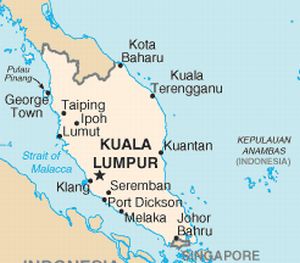|
MALAYSIA
|
|
|
|
|
|
|
|
Malaysia’s overall business environment will improve modestly, but at a slower rate than other countries in the forecast period; the country will slip to 27th position globally and eighth in the region. The ruling BN coalition will push on with structural reforms and will make some headway in diversifying the economy. The government is not expected to balance the budget in 2016‑20, amid heavy spending on infrastructure projects, continued low global oil prices and only limited tax rises. Malaysia’s macro-economic environment score will remain steady in 2016-20, keeping it at seventh place within the region. However it moves up one place to 26th position in the global rankings.
Smt. Sumitra Mahajan, Speaker of Lok Sabha and Prof. P J Kurien, Deputy Chairman of Rajya Sabha visited Malaysia during 8-13 January 2016 and represented India in the 23rd Session of Conference of Speakers and Presiding Officers of Commonwealth at Kota Kinabalu, Sabah. Hon’ble Speaker also held bilateral meeting with Tan Sri Mulia, MP, Speaker of Dewan Rakyat. An Indian Parliamentary delegation comprising six Members of Parliament from both Lok Sabha and Rajya Sabha, led by Shri Ravi Prakash Verma, Member of Parliament, Rajya Sabha paid a goodwill visit to Malaysia during 18-20 April 2016. The delegation called on the Malaysian Parliament Speaker and had interaction with the Heads of various Indian community associations.
At a glance
|
Country Name
|
Malaysia
|
|
Area
|
330,434 sq.km
|
|
Capital
|
Kuala Lumpur
|
|
Government type
|
Federal constitutional monarchy
|
|
Administrative divisions
|
13 states ( negeri-negeri, singular- negeri) Johor, Kedah, Kelantan, Melaka, Negeri Sembilan, Pahang, Perak, Perlis, Pulau Pinang, Sabah, Sarawak, Selangor, Terengganu; and 1 federal territory ( Wilayah Persekutuan) with three components, city of Kuala Lumpur, Labuan and Putrajaya.
|
|
National Holidays
|
Independence Day 31 August; Malaysia Day 16 September
|
|
Fiscal year
|
Calendar Year
|
|
Currency
|
Ringgit (MYR)
|
|
King
|
King MUHAMMAD V (formerly known as Tuanku Muhammad Faris Petra) (selected on 14 October 2016; installed on 13 December 2016);
|
|
Prime Minister
|
Mohamed NAJIB bin Abdul Razak (since 3 April 2009) |
|
Population
|
31,381,992 (July 2017 est.) |
|
Net migration rate
|
-0.3 migrant(s)/1,000 population (2017 est.) |
|
GDP (purchasing power parity)
|
$863.3 billion (2015 est.) |
|
GDP- composition by sector
|
Agriculture: 8.2 %
Industry: 37.8 %
Services: 54 % (2016 est.)
|
|
Agriculture- Products
|
Peninsular Malaysia - palm oil, rubber, cocoa, rice; Sabah - palm oil, subsistence crops; rubber, timber; Sarawak - palm oil, rubber, timber; pepper.
|
|
Industries
|
Peninsular Malaysia-rubber and oil palm processing and manufacturing, petroleum and natural gas, light manufacturing, pharmaceuticals, medical technology, electronics and semiconductors, timber processing; Sabah - logging, petroleum and natural gas production; Sarawak - agriculture processing, petroleum and natural gas production, logging
|
|
Major Exports
|
Semiconductors and electronic equipment, palm oil, petroleum and liquefied natural gas, wood and wood products, palm oil, rubber, textiles, chemicals, solar panels
|
|
Major Exports- Partners
|
Singapore 13.9%, China 13%, Japan 9.5%, US 9.4%, Thailand 5.7%, Hong Kong 4.7%, India 4.1% (2015)
|
|
Major Imports
|
Electronics, machinery, petroleum products, plastics, vehicles, iron and steel products, Chemicals.
|
|
Major Import- Partners
|
China 18.8%, Singapore 12%, US 8.1%, Japan 7.8%, Thailand 6.1%, South Korea 4.5%, Indonesia 4.5% (2015)
|
|
Natural resources
|
Tin, petroleum, timber, copper, iron ore, natural gas, bauxite
|
|
Languages
|
Bahasa Malaysia (Official), English, Chinese (Cantonese, Mandarin, Hokkien, Hakka, Hainan, Foochow), Tamil, Telugu, Malayalam, Panjabi, Thai note: in East Malaysia there are several indigenous languages; most widely spoken are Iban and Kadazan
|
|
Ethnic groups
|
Malay 50.1%, Chinese 22.6%, indigenous 11.8%, Indian 6.7%, other 0.7%, non-citizens 8.2% (2010 est.)
|
|
Climate
|
Tropical; annual southwest (April to October) and northeast (October to February) monsoons
|
|
Location
|
Southeastern Asia, peninsula bordering Thailand and northern one- third of the island of Borneo, bordering’ Indonesia, Brunei and the South China Sea, south of Vietnam
|

